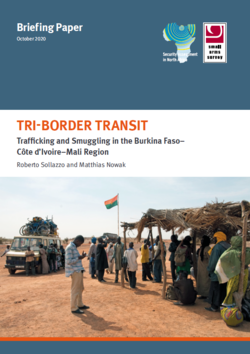
New SANA Briefing Paper on trafficking and smuggling in the Burkina Faso–Côte d’Ivoire–Mali Region
The tri-border area between Burkina Faso, Côte d’Ivoire, and Mali has long been an important zone of commerce for West Africa, and a key transit route for the trade flowing between the Gulf of Guinea, the Sahara, Sahel, and Mediterranean.
In recent years, smuggling and trafficking has risen in the subregion because of the growing demand for illicit goods and firearms. This demand is fueled by communities’ need for self-defense due to banditry and the increased presence of jihadist groups; needs of traditional hunters and non-state security providers; and the ecosystem around artisanal and small-scale gold mining in which criminals seek weapons to target the miners who in turn equip themselves with firearms for protection against attacks. These dynamics heighten the risk of insecurity and instability.
A new Briefing Paper by the Survey’s Security Assessment in North Africa (SANA) project, Tri-border Transit: Trafficking and Smuggling in the Burkina Faso–Côte d’Ivoire–Mali Region, takes a detailed look at the actors enabling smuggling and arms trafficking in the region, identifies the drivers of this traffic, and analyzes the impacts on local communities. The paper finds that there are three key trafficking axes in the area and that states are largely unable to control their borders and prevent these activities. The study also shows that illicit firearms are often trafficked together with other smuggled goods such as gold or drugs, using the ant trade method.
For media enquiries, please write to: media@smallarmssurvey.org
- Read Tri-border Transit: Trafficking and Smuggling in the Burkina Faso–Côte d’Ivoire–Mali Region
- Learn more about the SANA project
- Other recent SANA publications